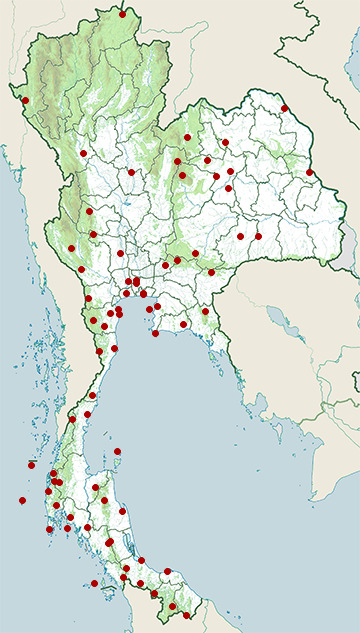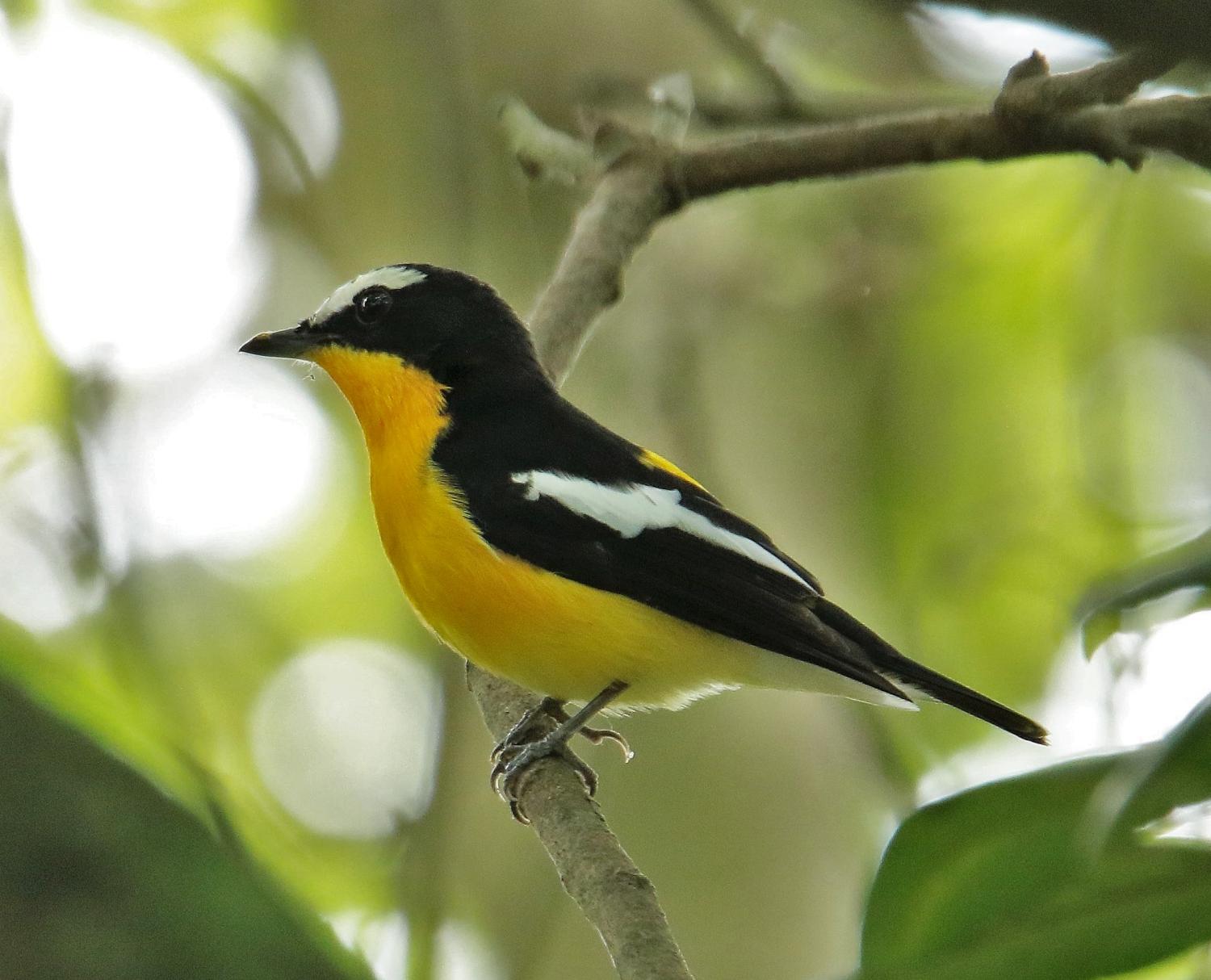Species of Thailand
Yellow-rumped flycatcher
Ficedula zanthopygia
Arthur Hay, A.K.A. Viscount Walden, 1845
In Thai: นกจับแมลงตะโพกเหลือง
The yellow-rumped flycatcher, Korean flycatcher or tricolor flycatcher (Ficedula zanthopygia) is a species of flycatcher found in eastern Asia. A distinctive species with almost no look-alike other than the narcissus flycatcher. It breeds in eastern Asia including parts of Mongolia, Transbaikal, southern China, Korea and western Japan. They winter in parts of the Malay Peninsula and South Asia.
Identification
In all plumages the yellow rump is distinctive. The white supercilium of the male is distinctive, separating it from the narcissus flycatcher and the Chinese flycatcher. Females and first year males are olive grey above with blackish tail.
Hartert (1910) treated this as a part of the narcissina group. Some individuals with yellow supercilium have been considered as hybrids with the narcissus flycatcher. Included in this species complex was the species called Elise's flycatcher, usually treated as a subspecies of the narcissus flycatcher. Both elisae and zanthopygia have been observed to breed separately in the same area of oak forest near Peking strengthening the case for their distinctness. There are also clear call and morphological difference between the two.
The genus Muscicapa has been noted to have been polyphyletic and is still in the process of being resolved although the genus Ficedula is now considered monophyletic with their origins in east Asia, with diversification following climate changes in the Pliocene.
Male have black upperparts with white supercilium and wingpatch, rich yellow underparts and rump. Female have greyish or olive-green above, paler below, with wingbar and yellow rump. May show yellow on throat.
Ecology
The breeding area of the species is in Manchuria, Korea and China. The nesting in Xiaoxingan region is mainly in May and June. They breed mainly in low valleys at the base of hills. The home range of a pair can be about 2000-5000 sq. m. The nest is built in about three to four days by the female alone. The clutch is 4-7 eggs which are incubated by the female alone for about 11–12 days. The adults forage within about 70 m of the nest to feed the chicks. The young fledge after 14–15 days. It was first noted to winter in central India in 1989, it has since been found to winter in southwestern India and Sri Lanka.
A species of ectoparasitic feather mite, Proterothrix megacaula was first discovered and described from the body of a yellow-rumped flycatcher in China.
This article uses material from Wikipedia released under the Creative Commons Attribution-Share-Alike Licence 3.0. Eventual photos shown in this page may or may not be from Wikipedia, please see the license details for photos in photo by-lines.
Category / Seasonal Status
Wiki listed status (concerning Thai population): Passage migrant
BCST Category: Recorded in an apparently wild state within the last 50 years
BCST Seasonal status: Mainly spring and autumn passage migrant
Scientific classification
- Kingdom
- Animalia
- Phylum
- Chordata
- Class
- Aves
- Order
- Passeriformes
- Family
- Muscicapidae
- Genus
- Ficedula
- Species
- Ficedula zanthopygia
Common names
- Thai: นกจับแมลงตะโพกเหลือง
Synonyms
- Xanthopygia tricolor, Gustav Hartlaub (1845)
Conservation status

Least Concern (IUCN3.1)
Photos
Please help us review the bird photos if wrong ones are used. We can be reached via our contact us page.
Range Map

- Ban Lat District, Phetchaburi
- Ban Phai District, Khon Kaen
- Bang Lang National Park
- Bang Phra Non-Hunting Area
- Bang Pu Recreation Centre
- Bang Saphan Noi District, Prachuap Khiri Khan
- Bangkok Province
- Chiang Saen District, Chiang Rai
- Hala-Bala Wildlife Sanctuary
- Huai Chorakhe Mak Reservoir Non-Hunting Area
- Huai Kha Khaeng Wildlife Sanctuary
- Kaeng Krachan National Park
- Kaeng Som Maew Queen Sirikit Forest Park
- Khao Banthat Wildlife Sanctuary
- Khao Chong
- Khao Dinsor (Chumphon Raptor Center)
- Khao Luang National Park
- Khao Nam Khang National Park
- Khao Phra - Bang Khram Wildlife Sanctuary
- Khao Sam Roi Yot National Park
- Khao Soi Dao Wildlife Sanctuary
- Khao Sok National Park
- Khao Yai National Park
- Khura Buri District, Phang Nga
- Klaeng District, Rayong
- Ko Sichang District, Chonburi
- Kromluang Chumphon Wildlife Sanctuary
- Kui Buri National Park
- Laem Pak Bia
- Mueang Khon Kaen District, Khon Kaen
- Mueang Krabi District, Krabi
- Mueang Nakhon Nayok District, Nakhon Nayok
- Mueang Nonthaburi District, Nonthaburi
- Mueang Pattani District, Pattani
- Mueang Phang Nga District, Phang Nga
- Mueang Phichit District, Phichit
- Mueang Phuket District, Phuket
- Mueang Samut Sakhon District, Samut Sakhon
- Mueang Songkhla District, Songkhla
- Mueang Suphanburi District, Suphan Buri
- Mueang Surin District, Surin
- Mueang Tak District, Tak
- Nam Nao National Park
- Nam Phong National Park
- Pak Phanang District, Nakhon Si Thammarat
- Pak Thale
- Pang Sida National Park
- Phi Phi Islands
- Phu Foi Lom National Park
- Phu Khiao Wildlife Sanctuary
- Phu Langka National Park
- Phu Pha Thoep National Park
- Phu Toei National Park
- Phu Wiang National Park
- Phutthamonthon District, Nakhon Pathom
- Sai Yok District, Kanchanaburi
- Sakaerat Environmental Research Station
- Salawin National Park
- Samae San Island
- Samut Prakan Province
- San Kala Khiri National Park
- Similan Islands
- Sri Nakarin Dam National Park
- Sri Phang Nga National Park
- Surin Islands
- Tai Rom Yen National Park
- Takua Pa District, Phang Nga
- Tarutao National Marine Park
- Tha Yang District, Phetchaburi
- Thale Ban National Park
- Than Sadet - Koh Pha-Ngan National Park
- Ton Nga-Chang Wildlife Sanctuary
- Wang Saphung District, Loei

